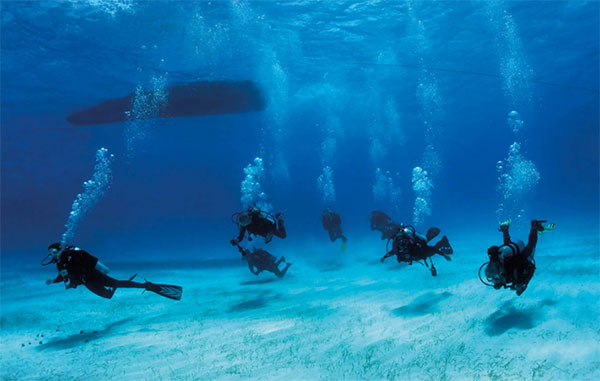WHITEWATER SAFETY
Sadly, every year whitewater accidents happen. Even the most experienced rafters, caught in a powerful river eddy, can drown. So choose your trip according to your level of expertise and find an outfitter that sticks to safety precautions: life vest, helmets, and accompanying safety/rescue kayaks. Before you enter the water in the raft you should have a practice drill to ensure everyone understands the instructions (often shouted over the thundering water). Also, check your travel insurance policy to ensure that you are covered for rafting. River water can be unsafe to drink, so if you do tumble in, keep your mouth closed!

Scuba diving group swimming from a dive boat, Half Moon Caye, Belize.
Robert Harding
Costa Rica was the regions original surf destination and it continues to be one of the most popular with quality waves that are normally suited to the average everyday surfer. There are plentiful, long mellow points and decent beach breaks and the water temperature is a comfortable 27°C (80°F) throughout the year. It gets harder every year but with such a diversity of spots there is still the chance of experiencing the rare thrill of having a wave all to yourself, just offshore from a pristine and empty beach.
On the Pacific Coast, many gravitate toward Jacó, for its easy access from San José; Playa Hermosa, site of many a surfing competition; and near Puntarenas, where the sandspit at the mouth of the Barranca River produces what is reputed to be one of the Central America’s longest left-breaking waves. Far to the north, the beaches of Guanacaste province have some of the best surf in the region, particularly during the dry season when steady offshore winds keep things smooth The break near Roca de la Bruja at Playa Naranjo is one of the most spectacular waves; the number of surfers is officially limited because it is in Santa Rosa National Park. Surfers need to make advance reservations with one of the many local surf shops and travel by boat to this surfing spot.
Near Limón, two and a half hours east of San José, Playa Bonita is a good, popular surfing beach. About one hour south of Limón, Puerto Viejo de Talamanca, a tranquil Caribbean village, is the site of the sometimes-awesome Salsa Brava, a surf break that has acquired an international reputation. From December through March, consistent, large north swells hit the coral reef with force.
While Nicaragua does not get the same amount of attention as Costa Rica, the country’s Pacific coast is not lacking in surf spots and more and more international surfers are discovering the delights of surfing Nicaragua. This is a year-round surfing destination, although the best swells occur from April to November. Most facilities center in the area around San Juan del Sur.
From December to April, large swells caused by winds originating in the Caribbean arrive at Costa Rica’s east coast beaches. The steep, fast-moving waves break over shallow coral reefs, often in shapes and sizes that rival those of the north shore of Oahu in Hawaii.
El Salvador is quickly finding its way on the region’s surf circuit. Many of the best waves can be found in the West, such as at La Libertad, Playa El Tunco, Playa El Sunza, and Playa El Zonte. The season here runs from about March to October, the rainy season. In Panama, some of the best waves are to be found on the Azuero peninsula, as well as at other points along the Pacific coast.
Diving and snorkeling
With the Pacific Ocean on one side and the Caribbean Sea on the other, Central America is paradise for scuba diving. Some of the most inexpensive certification courses can be found in the region, plus there’s a wide range of dive sites, from easy offshore locations in the Bay Islands to Belize’s Blue Hole.
Tracking the entire Caribbean coast of the Maya region – from Puerto Morelos in Mexico and south through Belizean waters to the Bay Islands of Honduras – is the world’s second-longest barrier reef, the Mesoamerican Barrier Reef System, an aquatic paradise for scuba divers. Like the Australian Great Barrier Reef, it is not just one continuous barrier or coral wall, though in many places the reef crest stretches for miles just below the surface. Additionally, there are hundreds of large and small coral-fringed islands or cayes, underwater seamounts and ridges, and four coral atolls.
Starting in the north, there’s some good diving around Isla Mujeres and Cancún, and there are several well-established dive schools on both islands. If you are in the area between May and September, you have the chance to snorkel with whale sharks, which gather off the coast and near Isla Holbox. Cozumel is the next important location, with some world-class diving on rich coral reefs, with deep trenches, coral patches, and steep drop-offs. Palancar Reef, which was first popularized by the French underwater explorer and marine biologist Jacques Cousteau, is justly famous throughout the diving world for its incredible coral wall. Other spectacular sites include Columbia Shallows, a dazzling coral garden, and Punta Sur, which offers wonderful coral formations (and also strong currents). There are plenty of dive schools in Cozumel.